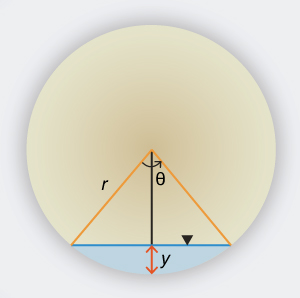QUESTIONS
When does uniform flow become unstable?
Under a Vedernikov number V = 1,
uniform flow becomes neutrally stable and this is conducive to the development of roll waves.
What is the Chezy formula based on?
The Chezy formua is based on a balance of frictional
and gravitational forces.
What is the difference between the Manning
and Chezy formulas?
In the Manning formula, the Chezy coefficient
is not constant, but varies with the hydraulic radius to the 1/6 power.
What is the minimum value of Manning's n
that can be achieved in practice?
n = 0.008, applicable to acrylic plastic (lucite).
What is the range of values of Manning's n
measured by Barnes?
0.024 ≤ n ≤ 0.075.
What is the range of values of Manning's n
measured by Arcement and Schneider for flood plains?
0.1 ≤ n ≤ 0.2.
Why is the calculation of composite roughness
using Eq. 5-43 only an approximation?
The derivation of composite roughness, Eq. 5-43,
assumes that the velocities are equal across the cross section of interest. However,
there is a high probability that the velocities in inbank and overbank sections are not equal.
What five input variables are used in the
computation of uniform flow in a trapezoidal channel?
(1) Discharge Q,
(2) bottom width b, (3) side slope z, (4) bottom slope S, and (5) Mannings's n.
Why is it better to use Newton's approximation
to the root rather than relying solely on the function approximation to solve the normal depth problem?
Because the Newton approximation, being based on the tangent,
results in a lesser number of iterations to obtain the answer.
What is the minimum ratio of reach length
to hydraulic depth in the slope-area method?
75.
What is the exponent of the discharge-depth
rating under laminar flow
conditions?
3.
What is the exponent of the discharge-depth
rating under turbulent Chezy friction in hydraulically wide channels?
1.5
What is the exponent of the discharge-depth
rating under turbulent Manning friction in hydraulically wide channels?
5/3 ≅ 1.667.
Under what value of Froude number is the flow
likely to become unstable under laminar flow conditions?
For F = 0.5.
PROBLEMS
Prove that the Darcy-Weisbach
friction factor is related to Manning's n by the following relation:
fD = 8 g n 2 / (k 2 R 1/3)
in which fD
= Darcy-Weisbach friction factor, g = gravitational acceleration,
R = hydraulic radius,
and k = constant specific for the system of units,
equal to 1 in SI units and 1.486 in U.S. Customary Units.
Express the relation in SI and U.S. Customary units.
Chezy equation:
V = C (RS)1/2
V 2 = C 2 RS = ( C 2 /g ) gRS = ( 8 / fD ) gRS [1]
Manning equation:
V = (k/n) R 2/3 S 1/2
V 2 = (k 2/n 2) R 4/3 S [2]
Equating [1] and [2]: (8 / fD ) g =
(k 2/n 2) R 1/3
fD = 8 g n 2 / (k 2 R 1/3) ANSWER.
In SI Units: fD = 8 (9.806) n 2 / (12
R 1/3) = 78.45 n 2 / R 1/3 ANSWER.
In U.S. Customary Units: fD = 8 (32.17) n 2 /
(1.486 2 R 1/3) =
116.55 n 2 / R 1/3 ANSWER.
A recent
flood on Clearwater Creek has left observable water marks on a certain river reach.
To estimate the flood magnitude, hydraulic data has been measured
at two cross sections A and B, a distance of 1,850 ft apart.
The reach fall between the cross sections is 9.1 ft and
the average Manning's n is 0.035.
The upstream flow area, wetted perimeter, and Coriolis α coefficient are
550 ft2, 55 ft, and 1.17;
the downstream flow area, wetted perimeter, and α coefficient are
620 ft2, 52 ft, and 1.10.
Use SLOPE AREA to calculate the flood discharge.
Run SLOPE AREA with the given data to calculate the flood discharge Q = 8,841 cfs. ANSWER.
Calculate the unit-width discharge in an overland flow plane, under laminar flow, with mean depth of 1.5 cm and slope of 0.001.
Assume water temperature T = 20oC. Report discharge in L/s/m.
q = [ g S / (3 ν) ] ym3
For T = 20oC: ν = 1. ×
10-6 m2/s
q = [ ( 9.81 × 0.001 ) / (3 × 1. × 10 -6) ] (0.015)3
q = 0.01103 m2/s
q = 0.01103 m3/s/m
q = 11.03 L/s/m ANSWER.
Use
ONLINE CHANNEL 01 to calculate normal depth, velocity, and Froude number
for the following case:
Q = 150 m3/s, b = 10 m, z = 2, So = 0.0005, n = 0.025.
Normal depth yn = 4.452 m,
normal velocity vn = 1.783 m,
normal Froude number Fn = 0.327
Use
ONLINE CHANNEL 01 to calculate normal depth, velocity, and Froude number
for the following case: Q = 250 cfs, b = 20 ft, z = 1, So = 0.001,
n = 0.030.
Normal depth yn = 3.476 ft,
normal velocity vn = 3.064 ft/s,
normal Froude number Fn = 0.31
Calculate the discharge Q using the Manning
equation, given: flow area A = 23.5 ft2; hydraulic radius R = 5.6 ft;
channel slope S = 0.0025; Manning's n = 0.035.
x
Calculate the discharge Q using the Manning
equation, given: flow area A = 45 m2; hydraulic radius R = 6 m;
channel slope S = 0.003; Manning's n = 0.04.
x
Given f = 0.0025,
calculate the discharge Q for a flow area A = 12.4 m2, hydraulic radius R = 2.1 m;
and channel slope S = 0.0015.
x
Given f = 0.0035,
calculate the discharge Q for a flow area A = 18 ft2, hydraulic radius R = 4.5 ft;
and channel slope S = 0.0018.
x
Derive
x
|
Fig. 1-14 Definition sketch for a circular channel.
|
|
| http://openchannelhydraulics.sdsu.edu |
|
140820 20:30 |
|
